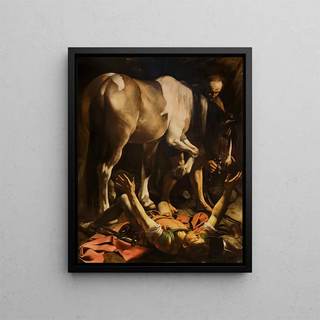Art print | Conversion of Saint Paul - Caravaggio


View from behind

Frame (optional)
The "Conversion of Saint Paul" is an iconic art print by Caravaggio, a master of Baroque painting. This artwork, created between 1600 and 1601, depicts a pivotal moment in the life of the apostle Paul, then Saul, who, on the road to Damascus, receives a divine revelation. The scene is filled with dramatic intensity, capturing the shock of spiritual transformation. Caravaggio, with his innovative approach, manages to transcend the simple religious narrative to offer a visual experience that profoundly touches the soul. Through light and shadow, he creates an atmosphere of mystery and revelation that engages the viewer and invites reflection on their own spirituality.
Style and uniqueness of the work
This art print stands out for its masterful use of chiaroscuro, a technique that highlights the contrasts between light and shadow. Caravaggio excels in guiding the viewer’s gaze, focusing attention on Saul’s face, illuminated by divine light, while the rest of the scene is shrouded in darkness. The figures are depicted with striking realism, almost sculptural, giving a sense of life and immediacy. The meticulous details, such as facial expressions and character postures, enhance the emotional intensity of the scene. The choice of colors, both dark and luminous, contributes to the dramatic atmosphere enveloping this conversion, making the art print both captivating and unsettling.
The artist and his influence
Michelangelo Merisi da Caravaggio, known as Caravaggio, revolutionized art in his time with his bold approach and unique perspective on the world. His innovative style influenced many artists, both contemporaries and successors, and his use of chiaroscuro paved the way for new artistic explorations. Caravaggio was able to capture humanity in his works, highlighting characters from everyday life, often marginalized, which allowed for immediate identification by the viewer with the subjects depicted. His ability to create emotionally charged and tense scenes has left a lasting impact.

Matte finish

View from behind

Frame (optional)
The "Conversion of Saint Paul" is an iconic art print by Caravaggio, a master of Baroque painting. This artwork, created between 1600 and 1601, depicts a pivotal moment in the life of the apostle Paul, then Saul, who, on the road to Damascus, receives a divine revelation. The scene is filled with dramatic intensity, capturing the shock of spiritual transformation. Caravaggio, with his innovative approach, manages to transcend the simple religious narrative to offer a visual experience that profoundly touches the soul. Through light and shadow, he creates an atmosphere of mystery and revelation that engages the viewer and invites reflection on their own spirituality.
Style and uniqueness of the work
This art print stands out for its masterful use of chiaroscuro, a technique that highlights the contrasts between light and shadow. Caravaggio excels in guiding the viewer’s gaze, focusing attention on Saul’s face, illuminated by divine light, while the rest of the scene is shrouded in darkness. The figures are depicted with striking realism, almost sculptural, giving a sense of life and immediacy. The meticulous details, such as facial expressions and character postures, enhance the emotional intensity of the scene. The choice of colors, both dark and luminous, contributes to the dramatic atmosphere enveloping this conversion, making the art print both captivating and unsettling.
The artist and his influence
Michelangelo Merisi da Caravaggio, known as Caravaggio, revolutionized art in his time with his bold approach and unique perspective on the world. His innovative style influenced many artists, both contemporaries and successors, and his use of chiaroscuro paved the way for new artistic explorations. Caravaggio was able to capture humanity in his works, highlighting characters from everyday life, often marginalized, which allowed for immediate identification by the viewer with the subjects depicted. His ability to create emotionally charged and tense scenes has left a lasting impact.






